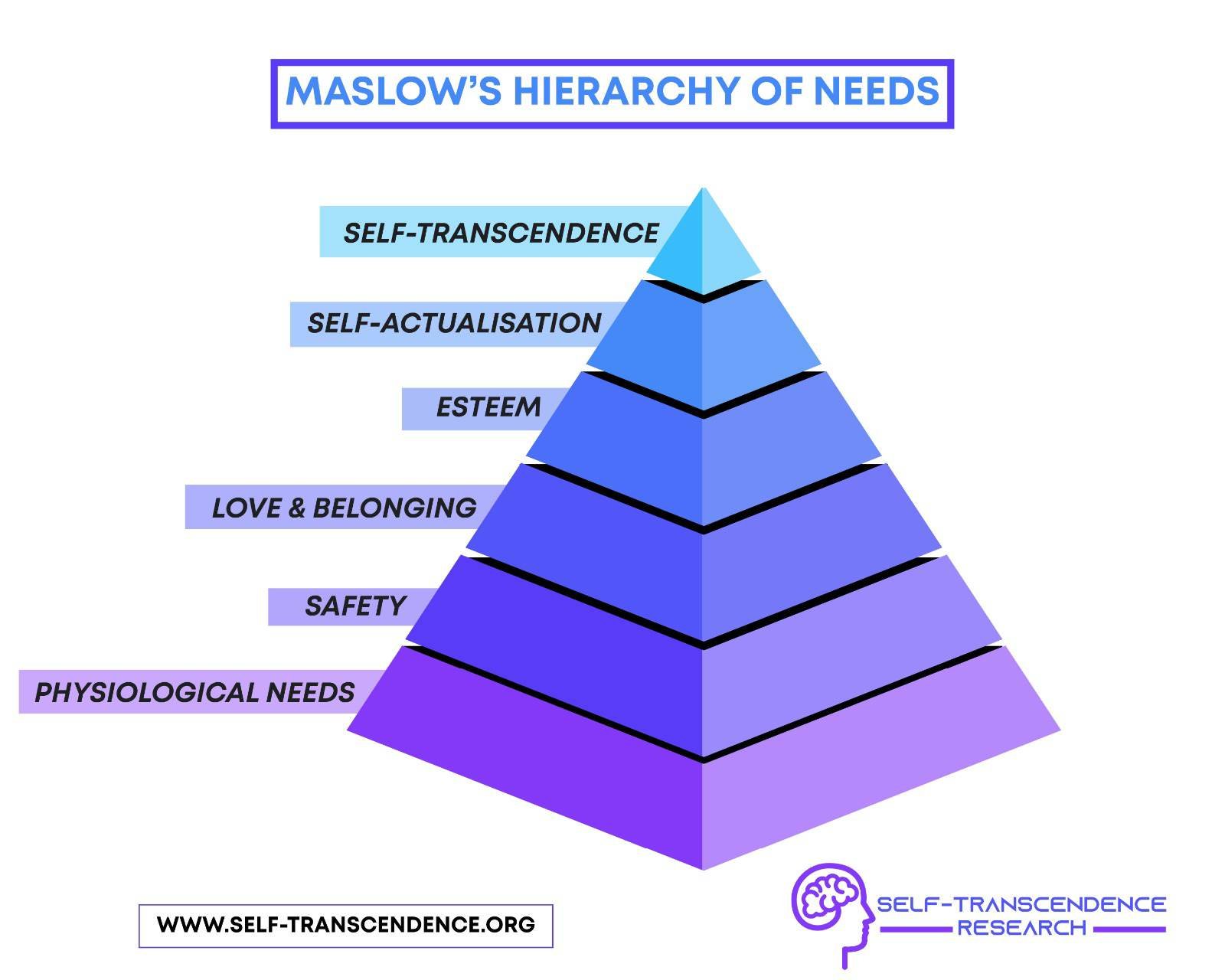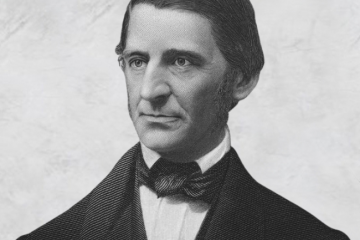Click below to listen to this article:
History of Maslow’s hierarchy of needs
Maslow‘s hierarchy of needs is a theory of human motivation that was proposed by Abraham Maslow, a psychologist and humanist, in 1943. He suggested that there are five levels of needs that humans strive to satisfy, from the most basic to the most complex: physiological, safety, belongingness and love, esteem, and Self-actualization.
Maslow based his theory on his observations of people he admired, such as Albert Einstein and Eleanor Roosevelt, as well as his own personal experiences. He believed that people have an innate drive to fulfil their potential and become the best version of themselves. He also argued that lower-level needs must be met to an extent, before higher-level needs can be pursued.
Common acceptance of the hierarchy
Maslow’s hierarchy of needs has been widely influential in various fields, such as education, management, marketing, and psychology. It has also been criticized for being too simplistic, culturally biased, and lacking empirical support. However, Maslow’s theory remains a popular and useful framework for understanding human motivation and behaviour.

Maslow’s hierarchy of needs is a theory of human motivation that proposes that people have a series of basic needs, which, it is commonly interpreted, must be met before they can pursue higher-level goals. The theory is often depicted as a pyramid with five levels: physiological, safety, love and belonging, esteem, and Self-actualization. Related to this are the universal primal needs.
Physiological needs
According to Maslow, the physiological needs are the most fundamental and include the requirements for survival, such as food, water, air, shelter, and sleep. These needs must be satisfied before a person can move on to the next level of the hierarchy.
Safety needs
The safety needs are the second level and involve the desire for security, stability, order, and protection from harm. These needs may include physical safety, financial security, health and well-being, and freedom from fear and anxiety. A person who feels safe and secure can focus on higher-level needs.
Love and belonging needs
The love and belonging needs are the third level and involve the need for interpersonal relationships, affection, intimacy, and belonging. These needs may include family, friends, romantic partners, social groups, and community. A person who feels loved and accepted can develop a sense of self-worth and confidence.
Esteem needs
The esteem needs are the fourth level and involve the need for respect, recognition, appreciation, and competence. These needs may include self-esteem, self-respect, achievement, status, reputation, and prestige. A person who has a high level of esteem can pursue their goals and aspirations.
Self-actualization needs
The Self-actualization needs are the fifth and highest level and involve the need for personal growth, fulfilment, and realization of one’s potential. These needs may include creativity, curiosity, knowledge, wisdom, self-expression, authenticity, and transcendence. A person who achieves Self-actualization can experience a sense of meaning and purpose in life.
self-transcendence needs
self-transcendence was added by Maslow towards the end of his life (Maslow, 1971, p. 269). It represents the highest level of the hierarchy of needs. According to Maslow, self-transcendence refers to the ability to transcend one’s own ego and personal interests, and to connect with something greater than oneself, such as a higher cause, a spiritual dimension, or the collective good. self-transcendence is not a specific goal or destination, but rather a continuous process of growth and expansion of one’s consciousness and awareness.
Maslow suggested that self-transcendence is a natural tendency of human beings, and that it can be fostered by certain conditions, such as peak experiences, altruism, creativity, meditation, and education. He also argued that self-transcendence is essential for achieving Self-actualization, which is the fulfilment of one’s potential and true natural self. Self-actualization and self-transcendence are interrelated and complementary aspects of human development.
self-transcendence can have various benefits for individuals and society, such as enhancing well-being, happiness, meaning, wisdom, compassion, empathy, and social responsibility. However, self-transcendence also poses some challenges and risks, such as losing one’s identity, becoming detached from reality, or being manipulated by external forces. Therefore, self-transcendence requires a balance between integration and differentiation, between unity and diversity, and between openness and discernment.
Criticism of our current “given understanding” of Maslow’s hierarchy
According to our current understanding, Maslow’s needs are arranged in a pyramid, with the lower-level needs being more basic and essential than the higher-level ones. We also tend to think that Maslow suggested that people need to satisfy their lower-level needs before they can move on to their higher-level needs.
However, this interpretation can be criticized for being too rigid and simplistic, as it implies that each stage of the hierarchy needs to be completed before the next one can be attempted. However, this is not what Maslow intended, in his later works, he clarified that any and all needs could be pursued simultaneously, depending on the individual and the situation. For example, he wrote: “So far, our theoretical discussion may have given the impression that these five sets of needs are somehow in such a rigid hierarchy that the lower need must be more or less satisfied before the next higher need emerges strongly. This is in fact not true” (Maslow, 1970, p. 49).
In reality, people can and do work on any and all stages at the same time, depending on their circumstances and goals. For example, a person who is hungry may still seek social interaction or creative expression, even though their physiological needs are not fully met. Likewise, a person who is self-actualized may still experience insecurity or loneliness at times, even though they have achieved their highest potential.
Therefore, our current understanding of Maslow’s hierarchy of needs is misleading, as it does not reflect the complexity and diversity of human motivation. It also ignores the influence of cultural and individual differences on how people prioritize and pursue their needs. A more flexible and dynamic approach to understanding human needs would recognize that people can fluctuate between different levels of the hierarchy depending on their situation and aspirations, and that they can also have multiple and overlapping needs at any given time.
Conflict with self-transcendence theory
The vulnerability aspect of self-transcendence theory Also seems to confirm Maslow’s true understanding of his model. It refers to the idea that when we face challenges, existential crises, or losses in our lives, we have an opportunity to expand our sense of self and connect with something greater than ourselves. This can be a source of meaning, growth, and resilience. However, this aspect of self-transcendence is at odds with the traditional model of Maslow’s hierarchy of needs, which suggests that we need to satisfy our basic physiological and psychological needs before we can pursue higher goals such as Self-actualization and self-transcendence.
According to Maslow’s original theory, self-transcendence was not even part of the hierarchy, but rather a possible outcome of Self-actualization. Later in his life, Maslow revised his theory and added self-transcendence as a higher level of human development beyond Self-actualization. He argued that self-transcendence is not a luxury or a distraction from our lower needs, but rather a natural expression of our human nature and a way of transcending our ego-boundaries. He also suggested that self-transcendence can help us cope with our existential anxieties and find a deeper sense of purpose and fulfilment in life.

Alternative interpretation of Maslow’s hierarchy
Based upon these comments, it’s possibly better not to think of the hierarchy of needs as a stepped pyramid, but rather as a pyramid where all elements are accessible from the bottom levels. meaning, individuals at any point in their life journey have the potential to develop all aspects of the hierarchy simultaneously. Thus, an individual at the very bottom of the physiological scale still has potential to find self-transcendence, as inferred by self-transcendence theory.
Links
The following links provide further information about Maslow’s hierarchy of needs:
Maslow’s hierarchy of needs – Wikipedia
What is Transcendence? The True Top of Maslow’s Hierarchy of Needs – SLOWW
References
Maslow, A. H. (1970). Motivation and personality (2nd ed.). Harper & Row.




0 Comments